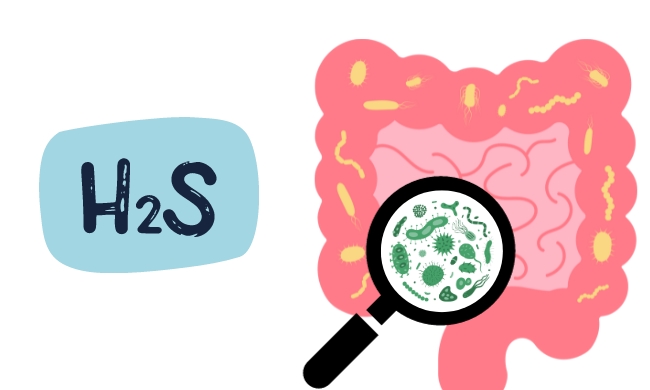Gut health and hydrogen sulfide.
In the search to understand your gut health, you may have read about the gut microbiome, and how it might be linked to some of your uncomfortable symptoms like bloating and gases such as hydrogen, methane and hydrogen sulphide. When microbes in your gut break down food components like fiber, gases are produced as a by-product. The levels of gases, like hydrogen and methane, in your breath can provide insights into the inner workings of your digestive system and can be especially useful for diagnosing gastrointestinal conditions like small intestinal bacterial overgrowth (SIBO).
Hydrogen and methane are useful for pinpointing and managing gut health problems, but they are not the only gases produced by your gut microbiome that might provide clues that you have a condition impacting your health.
What is hydrogen sulfide?
Hydrogen sulfide (H2S) is a gas produced by a specific group of gut microbes in the small intestine, known as sulfate-reducing bacteria. These bacteria are able to feed on the hydrogen produced when other gut bacteria break down food, generating hydrogen sulfide as a result. The hydrogen sulfide is then transported through the circulatory system to the lungs, exhaled on breath, and can be detected in a similar manner to hydrogen and methane.
Hydrogen sulfide can also be produced by human enzymes within the body, so not all exhaled hydrogen sulfide comes from gut microbes. One study found that hydrogen sulfide levels in germ-free mice (mice with no gut bacteria) were half that of mice with normal gut bacteria, suggesting that microbes in the digestive system produce around 50% of the hydrogen sulfide found on breath 1.
Hydrogen sulfide might provide insights into digestive disorders
High concentrations of hydrogen sulfide in the gut have been associated with a number of digestive conditions, including inflammatory bowel diseases (IBD) like Crohn’s disease and ulcerative colitis, and irritable bowel syndrome (IBS) 2. Gut bacteria producing high levels of hydrogen sulfide can damage the delicate cells in the colon and hydrogen sulfide can interfere with the ability of gut cells to use energy molecules like short-chain fatty acids 3. A combination of these mechanisms likely drives some of the gut inflammation seen in conditions like IBD and IBS.
The levels of hydrogen sulfide may also provide new insights into digestive disorders like SIBO. A 2016 study explored the levels of hydrogen sulfide on breath in diarrhea-predominant IBS patients with and without SIBO after consumption of a glucose test drink (fuel for SIBO bacteria) 4. Researchers found that SIBO positive patients had a higher proportion of hydrogen sulfide on their breath than SIBO negative patients. An increased level of hydrogen sulfide was also found in SIBO positive patients whose exhaled hydrogen levels did not increase.
Low hydrogen on breath after a glucose test drink would normally indicate that SIBO bacteria were not present, but in this instance, scientists hypothesized that sulfate-reducing bacteria consumed the hydrogen from SIBO bacteria, releasing H2S instead 4. These results highlight how monitoring hydrogen sulfide on breath alongside hydrogen might be able to help with the diagnosis of SIBO in patients that would otherwise have not been diagnosed and left in the dark about the cause of their digestive discomfort.
Are there tests available for hydrogen sulfide?
At the moment, breath testing for gut health conditions like SIBO and carbohydrate malabsorption is carried out using the levels of exhaled hydrogen and methane – two important gases produced as gut bacteria break down carbohydrates. Looking at the levels of hydrogen sulfide in breath would add a new dimension to the interpretation of gut health breath test results as it could indicate the presence of different bacteria contributing to conditions like SIBO, which might need to be treated differently.
At the moment, in the UK it is not possible to routinely measure hydrogen sulfide for SIBO or IBS via breath testing and caution should be taken if a service refers to a result of a gas that is not measured. However, our latest research is exploring new ways to measure hydrogen sulfide via a breath test, with promising results!
We can help you to take control of your gut health
We believe in empowering individuals to take control of their digestive health through better insight and ongoing support. That is why we developed the OMED Health Breath Analyzer and App, an at-home solution that measures hydrogen and methane levels in your breath and helps you track lifestyle factors such as diet, stress, and exercise.
As part of the OMED Health Plans, your breath data is reviewed by our in-house doctor to support the diagnosis of conditions such as SIBO. If a diagnosis is made, we provide a personalised treatment plan and ongoing monitoring so you can understand how your gut is responding over time.
Take a clinically supported, data-driven approach to improving your gut health. Purchase the OMED Health Breath Analyzer Device to get started.
References
- Flannigan KL, Mccoy KD, Wallace JL. Eukaryotic and prokaryotic contributions to colonic hydrogen sulfide synthesis. Am J Physiol Gastrointest Liver Physiol. 2011;301:188-193. doi:10.1152/ajpgi.00105.2011.-Hydrogen
- Dordević D, Jančíková S, Vítězová M, Kushkevych I. Hydrogen sulfide toxicity in the gut environment: Meta-analysis of sulfate-reducing and lactic acid bacteria in inflammatory processes. J Adv Res. 2020;27:55-69. doi:10.1016/J.JARE.2020.03.003
- Rowan FE, Docherty NG, Coffey JC, O’Connell PR. Sulphate-reducing bacteria and hydrogen sulphide in the aetiology of ulcerative colitis. British Journal of Surgery. 2009;96(2):151-158. doi:10.1002/bjs.6454
- Banik GD, De A, Som S, et al. Hydrogen sulphide in exhaled breath: A potential biomarker for small intestinal bacterial overgrowth in IBS. J Breath Res. 2016;10(2). doi:10.1088/1752-7155/10/2/026010



